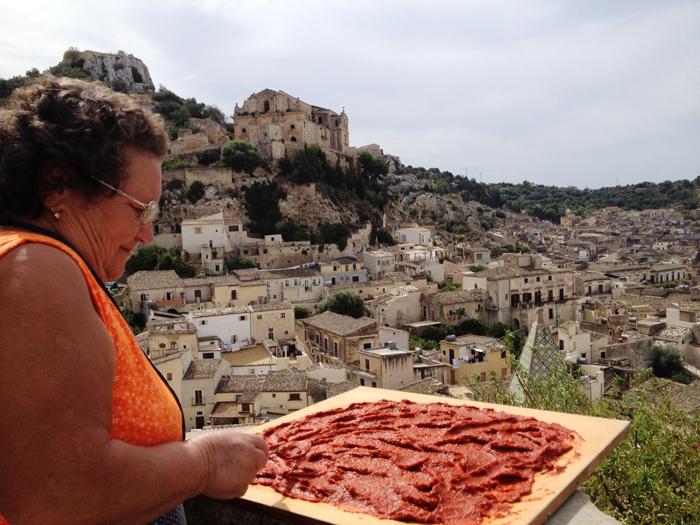For our Italian Delicacies series, we are heading to Sicily this week to tell you about the region’s classic tomato paste, 'strattu. When you visit Sicily during the hot summer months, you will most likely see big ceramic plates or wooden casings in the streets and on people’s balconies containing a deep red sauce. That is homemade Sicilian tomato paste and, according to many, one of the secrets to some of the tastiest local recipes. Pat Eggleton shares her experience of making ‘strattu at the home of a local family with us.
‘Strattu [the dialect word for estratto] is a thick tomato paste that Sicilians make along with their annual supply of tomato sauce and it livens up pasta sauces no end. No Sicilian would make a pork ragù without adding a goodly dollop of ‘strattu and I find a little of it adds depth to any recipe requiring tomato sauce.
I do make my own tomato sauce every year but I have come to the conclusion that, unless you have a source of home-grown tomatoes, it is not worth trying to produce your own ‘strattu, especially these days when you can buy excellent ‘strattu in any salumeria or supermarket. However, I love to be invited to the home of my friends Marco and Giovanna on ‘strattu-making day and I thought I’d tell you about it.
The great day usually falls in July, for the sun has to be hot enough to dry the sauce out completely over several days. Giovanna and her 82-year-old mother-in-law are equipped with aprons and their hair is tied up in kerchieves, for making ‘strattu can be a messy business! The preparation takes place in the garage, which has a cooker and about four cratefuls of tomatoes – a mixture of plum and cherry varieties - ready to be processed. In Sicily in summer, tomatoes cost about 4 euros a crate.
Like most Sicilian families, Marco and Giovanna have a collection of enormous pans so all these have been brought downstairs for the boiling of the tomatoes. They also have a large electrical machine which extracts the pulp. Giovanna and her mother-in-law throw the boiled tomatoes into the machine and in seconds some gloriously scarlett pulp appears in a container beneath the machine’s spout. La signora stirs this with a wooden stick and declares it “buona”. Then the skins go back into the machine for a second pressing, for every possible drop of juice must be extracted.
Now the purée is salted and Giovanna adds a little salicylic acid as a preservative (Not all families add this). Then comes the part I like best: the pulp is spread into special, shallow trays and these are set out on trestle tables in the garden. There the trays will remain until the pulp becomes leathery in texture and it will be stirred often over the next few days. As a Brit, I‘m still amazed that I live somewhere where you can be confident that it won’t rain for five whole days!
By this stage, Marco has cleaned the machine and is on pan-washing duty while the youngest of his children is trying to dip a finger into one of the trays without his mother seeing him. This amount of tomatoes will make only about 2 kg of the precious paste, but it will taste of the sun and bring warmth into the family’s lives for another year.
[Photo above courtesy of Scicli Albergo Diffuso.]
Don't miss out on Italian deliciousness, follow our weekly Italian delicacies series here.












